FY21
Annual
Review
May 1, 2020–April 30, 2021
Chronicle X, by playwright, director, and performer Nia Witherspoon (2019 Jerome Hill Artist Fellow), presented by Musical Theatre Factory, HERE, and The Shed. Photo by Ahad Subzwari.
Annual Review
What a year it was.
FY21* brought, among other phenomena, the long overdue reckoning around ongoing systemic racism, sparked in large part by the murder of George Floyd here in Minnesota, the COVID pandemic, deep political divisions, social unrest, election violence and new levels of ongoing disinformation—all of which shaped social interactions, personal relationships and business practices in powerful ways. In the wake of COVID, businesses in all sectors enacted major layoffs, shifted to remote office structures and, in many cases struggled to survive (not all successfully). Workers in all industries entered complex new lives, many confronting loss of employment and/or benefits, radical reductions in income and the need to simultaneously juggle home schooling, health care and work from home, among other challenges.
Arts organizations and artists were disproportionately impacted by all of these trends. Artists—especially freelance artists—lost not only performance, exhibitions and screening opportunities but also those “day jobs” in other sectors on which they had depended for critical income and benefits (including health care). Many artists from financial necessity relocated during the pandemic or took up work in other sectors, leading to possibilities of an enormous long-term talent drain.
But specific disciplines were impacted differently, even while organizations in every discipline reduced staffs, trimmed salaries, slashed budgets and more. Literature—with its dependence on authors who frequently already write in isolation and its already accomplished migration to electronic and virtual platforms—had, according to some accounts, a surprisingly robust year, especially as citizens forced to stay home turned more and more to reading for solace and enjoyment. Film migrated even more to virtual distribution. Visual arts organizations began to test re-emergence by placing severe limits on attendance and using staggered gallery visits times, while performing arts facilities generally remained closed entirely. Whatever the discipline, it was a year in which reserves were depleted and in which the ability to attract and retain donors—who themselves were experiencing heightened pleas for support from every sector—became more and more critically important. The already fraught competition for the traditional contributed dollar became even more intense.
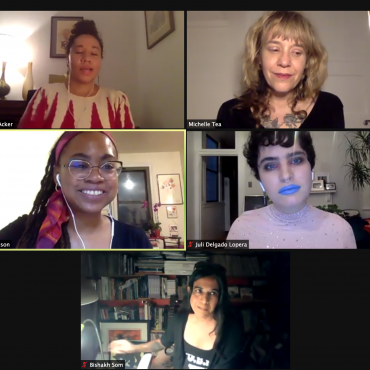
Celebrating 50 years of The Feminist Press.
Many artists and organizations looked at this chapter as a forced hiatus or interruption. Their concerns were focused on when and how they might best resume and return to the missions and values they had pursued before. Their dedication and passion remained strong, while their strategic questions often were driven by internal concerns and their primary vantage point lay in reasserting their historic value.
Others saw this moment as a moment to redefine and restructure. They more frequently looked outwards to question how best to attach to current community needs, reimagining and restructuring workplace, leadership, communication, presentation and missions, often with increased attention to a current and future civic value as well as to the artistic value.
And still others—particularly younger artists and those committed to social justice—emerged in entirely new ways, proclaiming the value of a solidarity economy and inventing new opportunities for mutual support, even while calling into question the larger structures of public and private support on which the arts have historically depended.
Throughout the entirety of the year, Jerome Foundation staff were deeply inspired by the dedication, the creativity, the persistence and the courage of arts professionals, whichever of these paths they had chosen. This was a year in which communities saw the launch of Zoom performances in theater and dance, an explosion of radio plays, the flourishing of artwork in street murals and protest paintings, enhanced public participation through interactive arts classes taught online, musical porch performances broadcast through the internet and more—the courageous proclamation of an industry that it would not be defeated, even while many of these activities brought little if any renumeration and were often borne on the backs of the artists themselves.
As the Jerome Foundation closed its fiscal year on April 30, the country was in a nascent moment (barring the outbreak of a new variant virus) of a thaw, a returning. With the wider access to COVID vaccines, relaxed federal restrictions on masking in outdoor settings and greater percentages of the population already vaccinated, arts organizations were cautiously ramping up and coming back. Live in-person performances were on the rise, limited capacity seating in auditoria was being tested, and organizations were beginning to restaff—a process that, while an enormous opportunity to reconfigure the workforce with more racially and generationally diverse staffs, will require not only restaffing but also reconceiving and redefining the entire organizational culture.
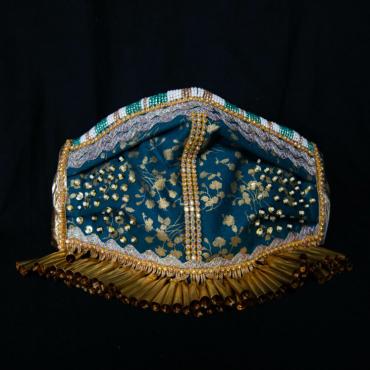
COVID mask created by Adrienne Benjamin. All My Relations Gallery asked artists to create one artistic mask and 30 to be functional and donated to the Metropolitan Urban Indian Directors Group. Photo by Jaida Grey Eagle.
Now hanging over this gathering momentum are very real questions: what will happen as the current Delta variant gathers momentum or if an even more aggressive COVID variant appears? How rapidly will audiences feel comfortable sitting in closer proximity to one another? What impact has the explosion of virtual product had on live attendance? How will organizations reconcile their own social goals with union agreements, which in many cases tie the hands of arts organizations in whom they may hire? Will donors continue to support organizations in their return—especially those whose donations last year were unused and unclaimed tickets and/or those for whom the arts have been not a primary cause but a secondary one? Having opened the virtual portals more extensively in many cases, how can artists and organizations positively monetize these efforts? Indeed, what will be the proper future balance of resources—both energy and monies—between the virtual and the live?
While their financial assets and an unprecedently strong market have largely insulated private foundations (including Jerome) from these pressures, this year has been one that has required deep self-reflection. In this moment of upheaval, many voices have urged philanthropy to consider significant changes, many of which Jerome had already been embracing: the shift to multiyear grants, to more flexible forms of support with greater emphasis on general operating support, to involving communities in deciding grants and defining priorities, and to making greater investment in BIPOC communities. But these methods and strategies were only a piece of a larger set of challenges being raised.
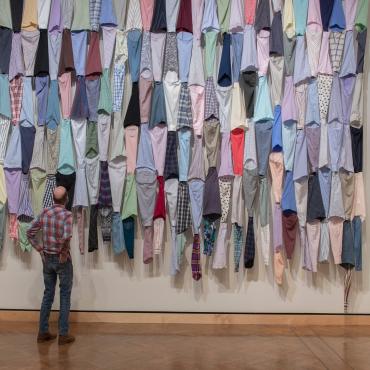
Installation view of The Labor We Wear (Minneapolis Institute of Arts) by 2019 Jerome Hill Artist Fellow Rachel Breen.
Deeper conversations tied the concept of philanthropy to colonial structures that have perpetuated racism and oppression. Now, many asked, how should the source of foundation wealth inform the causes and the beneficiaries that foundations support? How should foundations leverage investing practices to rectify historic inequities? Should Foundations have shorter life spans instead of perpetuity and be compelled to distribute more than the historic 5% minimum?—questions that Jerome began to examine during this last year as we opened discussions of ESG investing, committed to giving significantly above its 5% minimum over a five year period, and stepped more and more deeply into understanding imperatives around equity.
Only time of course will tell, but the coming year will be as challenging but as full of opportunity—albeit in very different ways—than the past. We continue to look to artists to inspire, inform and help the lead the way into a better future for us all.
* The Jerome Foundation fiscal year referred to in this report covers the period of May 1, 2020–April 30, 2021.
Grant Giving Highlights for FY21
In FY21, the Foundation paid a total of $5.3M in grants—more than $1.6M above its originally approved grants budget—and made additional commitments of $3,445,550 for future years. A list of specific payments made in FY21 will be posted as part of the Foundation’s annual PF-990 tax return, which will be posted to this website by September.
A summary of the Highlights of FY21 follows below.
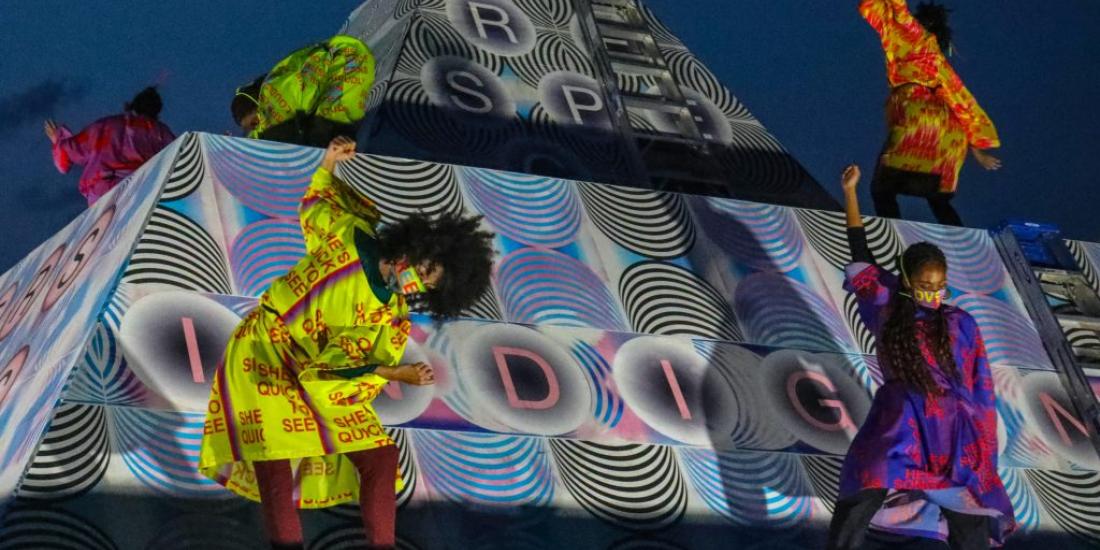
Emily Johnson performance at Jeffrey Gibson’s Because Once You Enter My House It Becomes Our House at Socrates Sculpture Park. Image by Scott Lynch.
COMMITMENT TO EXTRAORDINARY GIVING
$1.125M Paid
Additional $832,500 future commitments made and $6,042,500 allocated
With the continuation of the COVID crisis and the deepening distress experienced by artists and arts organizations, the Foundation reconsidered its long-standing policy of hewing closely to the 5% minimum distribution requirement in order to grow assets over time and increase the Foundation’s giving in both grant size and number of awards.
A number of other prominent foundations—notably Ford, Andrew W. Mellon and Doris Duke—had been deeply inspiring by their extraordinary commitments. The Jerome Foundation discussion asked Directors and Members to consider issues of annual growth goals, the Foundation’s mission, its core values, its assumption of perpetuity and the urgency of the moment.
In September 2020, the Board agreed to commit an additional $8M for grants above and beyond the 5% minimum between FY21–25. Recognizing however the likely disappearance of temporary government relief efforts and the potential of donor fatigue, the Foundation consciously agreed to spend funds deliberately and reserve the bulk of these funds for distribution in FY 23–25.
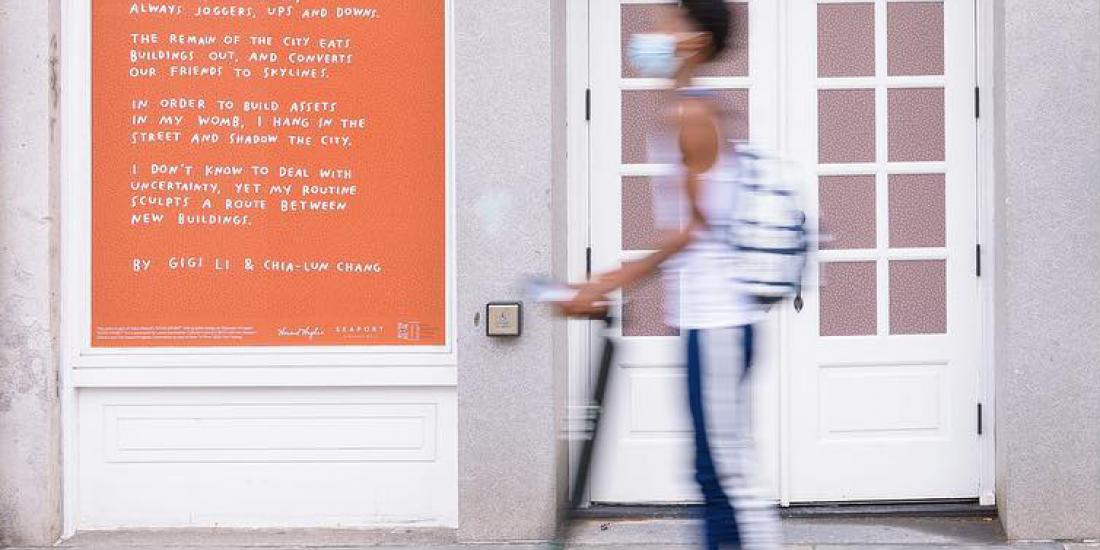
Poem (on left) co-authored by 2019 Jerome Hill Artist Fellow Chia-Lun Chang (from Asiya Wadud’s Echo Exhibit).
DIRECT GRANTS FOR ARTISTS
$1.98M Paid
Additional $3M future commitments made
Jerome Hill Artist Fellows. In FY21, the Foundation made final payments totaling $1.5M to Fellows chosen in the inaugural round of this program in 2019 and selected the recipients for 60 Fellowships totaling $3.0M over the next two years. Given the quality of the more than 820 applications and the extraordinary nature of the times, the Foundation elected to award additional small grants to applicants who had ultimately not been designated as grantees but had been identified by panels as finalists ($5,000 each) or alternates ($7,500 each) for a total of $480,000.
Jerome Hill Artist Fellowships support artists in dance, film/video/new media, literature, music, theater/performance/spoken word and/or visual arts at early stages in their careers to create new work, enhance their artistic development and/or engage in activities that would enhance their professional careers.
Fellowships are valued at $25,000 each year for two successive years. Fellowship recipients also can elect to receive free individualized professional development counseling provided by the MAP Fund of New York or in the first round also by Springboard for the Arts in St. Paul, MN.
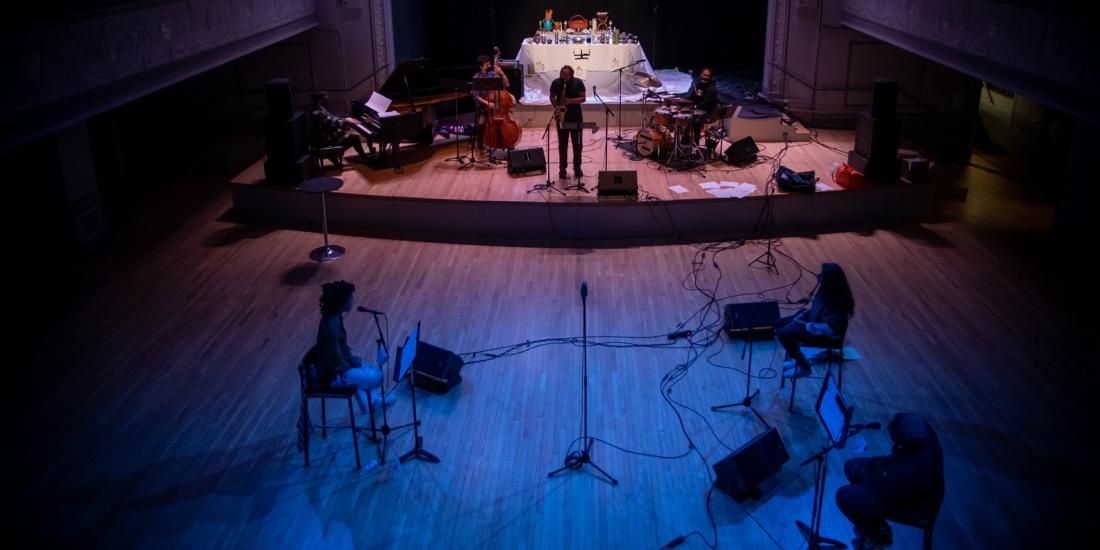
Immanuel Wilkins’ BLUES BLOOD | BLACK FUTURE at Roulette Intermedium
DIRECT GRANTS FOR ORGANIZATIONS
$2,365,084 Paid
Additional $1,714,800 future commitments made
In January 2020 (before the onset of COVID), the Foundation had awarded two-year project grants to organizations with first payments scheduled for FY21. With the outbreak of COVID, the Foundation responded initially by removing the project restrictions and restructuring these grants as flexible operating grants. This step gave organizations both the confidence and the latitude to respond more holistically to the changes around them as they made difficult decisions in hopes of survival. More than 2/3 of the grantees reported that they continued to target the bulk of funds towards serving early career artists, while noting this latitude gave them the ability to support them in new ways that were more responsive and appropriate to the times than the original projects would have been.
Additionally, recognizing both the same depth of applicant merit beyond the grantee roster and and the challenging nature of the times, the Foundation chose to expand the roster of organizations funded in January 2020 (less than two months before the COVID pandemic outbreak) by offering grants to finalists ($35,000) and alternates ($40,000 ) over two years for total additional awards of $477.5K.
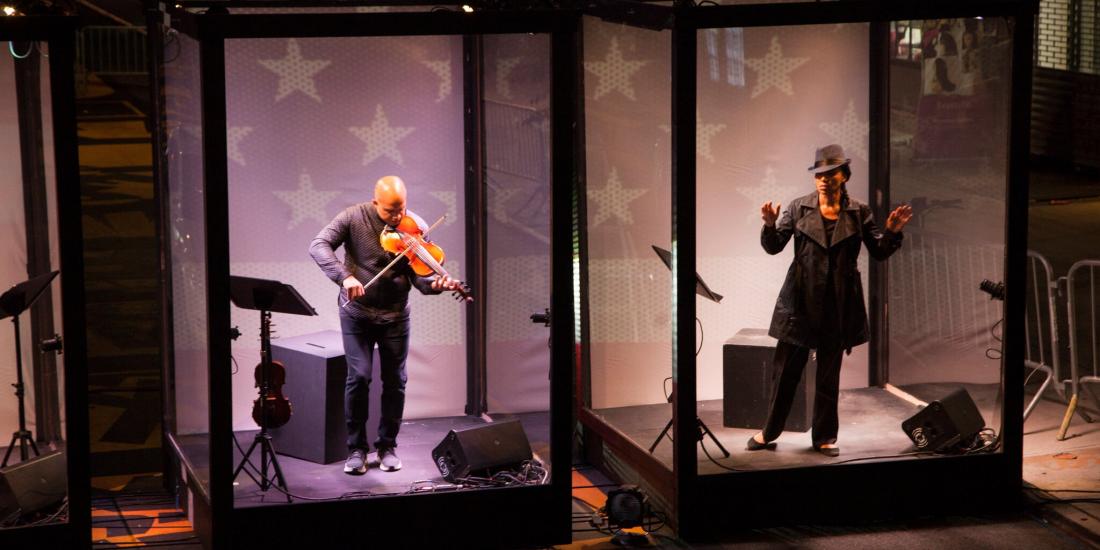
Twelve Angry Men... and Women, staged by the Billie Holiday Theater in Brooklyn. Photo by Hollis King/The Billie Holiday Theater.
CONSORTIUM GRANTS FOR ORGANIZATIONS
$500K Paid
Additional $500K commitments made
The Foundation also heard, especially from BIPOC organizations, the need for deeper investment and more consolidated approaches to maximize income and reduce the time dedicated to fundraising from multiple discrete sources. In addition to the grants determined and awarded directly by the Foundation, Jerome joined collectives of other funders and awarded an additional $1 million to support BIPOC Organizations in Minnesota and New York City. These grants included $600,000 awarded to Propel for Nonprofits in Minneapolis MN in support of Seeding Future Treasures and $400,000 to the New York Community Trust in support of the Mosaic Network and Fund.
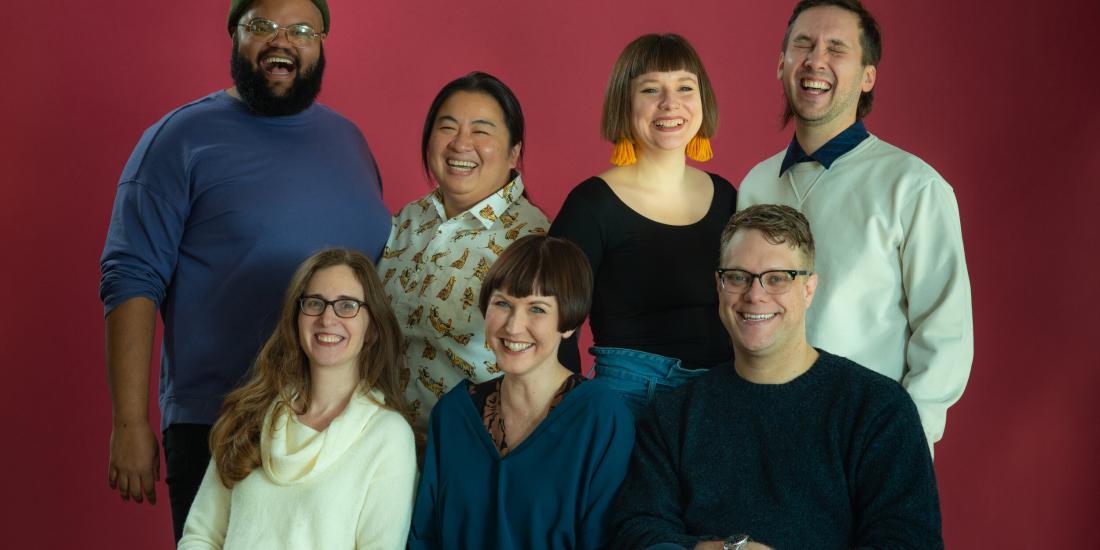
The seven artistic directors of Red Eye Theater, an artist-led organization with a collective leadership model.
PILOT GRANTS FOR NEW LEADERS
$20K Paid
Additional $30K commitments made
A more focused portfolio of small grants was created to recognize the critical nature of leadership transitions at organizations, especially in this moment. With many organizations financially pressed, resources to conduct searches were scarce. Additionally, new leaders were (or would be) asked to assume their positions in a moment with little discretionary money with which they could launch new activities, conduct research, engage consultants, find new ways to rebuild the organizational culture, and more. Through a series of grants in Minnesota, the Staff began to test a pilot initiative supporting leadership transitions with a double focus of support for searches and support for discretionary funds for the new leader once in place.
These by-invitation only grants were generally limited to $10,000 to support a search and $10,000 for a new leader discretionary fund, and to organizations with which the Foundation already had a significant funding history. The Foundation will be monitoring the use and value of these funds in the coming year and will decide whether to expand this program in scale or geographic reach.
Commitment to Equity, Diversity and Inclusion
Throughout the year, every committee’s work and every Board action was examined through an EDI lens to ensure that the Foundation’s commitment was realized in action in every dimension of the organization.
In FY21, the Foundation continued its exploration of Equity, Diversity and Inclusion, guided an internal EDI Working Group composed of Directors, Members and Staff. In FY21, the Board engaged in a mini-retreat, led by the Giving Practice of Seattle, WA, and met with Minnesota Council on Foundations President Susie Brown and the Women’s Foundation of Minnesota Chief Strategy and Innovation Officer Lulete Mola to learn about EDI progress in the larger philanthropic sector. The Foundation subsequently issued an RFP for assessment, training and planning in FY22, which was ultimately awarded to The Equity Project of Denver, CO.
In examining its own assets, the Foundation began initial examinations of ESG investment strategies for the future. It also began deeper consideration of its inherited timber properties, with different board meetings featuring presentations from timber management experts, Hill family descendants and Northwest Native American tribal leader Bud Lane.
In FY21, 64% of Jerome-supported programs at organizations were led by BIPOC directors or executives. Individual artists were asked to self-identify those dimensions they found most salient to their identifies and within their comfort levels. 82% of Jerome Hill Artists fellows receiving funding in FY21 and 86% of Jerome Hill Artist Fellows chosen in FY21 to receive funding over the next two years identified as BIPOC. 58% identified as Female, 32% as Male, 5% as transgender and an additional 23% as gender fluid and/or Gender non-conforming (some artists chose multiple identifications). Many artists additionally identified specific characteristics of nationality, immigrational generation, religion, family role and/or geography, to cite a few additional dimensions cited by multiple artists.
In measuring its own demographics, the Foundation was attentive to race, gender, generation and physical ability. Of the 73 panelists used by Jerome in FY21, 75% were BIPOC, 58% female, 64% heterosexual, and 1% part of a disability community. Of the 9 members of the FY21 Jerome Foundation Board of Directors, 6 identified as BIPOC (67%) with representation from African descent, Asian descent and Native American communities and 5 as female (55%). 44% of Directors were Baby Boomers, 33% were Gen X and 22% Millennials. Within the full-time Jerome staff of 4, 3 identified as European descent (75%), 2 as female and 1 as gender non-conforming; 75% as gay/queer; and as Baby Boomers (25%); Gen X (25%) and Millennials (50%). There were no people with reported disabilities on either the staff or the Board.
More specific charts are found at the end of this report.
Administration, Finance, Governance and Management
Administrative expenses for the year totaled $1,139,482, inclusive not only of all rent, salaries, benefits, consultant fees, technology, etc., but also of all panel meeting expenses, panelist honoraria and memberships in philanthropic associations.
Foundation assets showed remarkable growth in FY21, increasing in average annual value by almost 30% from the prior year. The year ended with Foundation assets totaling $128,740,399.
The Jerome Foundation is governed by a Board of Directors, elected by the Members of the Jerome Corporation, a small circle of individuals connected to the Hill family either by interest or by heritage who are charged with preserving the legacy of founder Jerome Hill. In FY21, these individuals were as follows:
BOARD OF DIRECTORS
Officers
Chair: Linda Earle, Professor of Practice in Art History at the Tyler School of Art at Temple University (New York, NY)
Vice-Chair: Kate Barr, Executive Director of Propel Nonprofits (Minneapolis, MN)
Secretary: Daniel Alexander Jones, performer/writer (New York, NY)
Treasurer: Retired McKnight Foundation Vice-President of Finance Rick Scott (Minneapolis, MN)
Directors
Sarah Bellamy, Artistic Director of Penumbra Theater (St. Paul, MN)
Thomas Lax, Curator of Media and Performance at the Museum of Modern Art (New York City
Lori Pourier, President/CEO of First People’s Fund (Rapid City, SD)
Sanjit Sethi, President of the Minneapolis College of Art and Design (Minneapolis, MN)
Elizabeth Streb, Founding Director and Choreographer of Streb (New York, NY)
THE MEMBERS OF THE JEROME CORPORATION
Sara Maud Lydiatt-Vanier, Chair (Montreal, CA)
Elizabeth Hlavka (Minneapolis, MN)
Nicholas Slade (St. Paul, MN)
William Sheeline (Oyster Bay, NY)
STAFF
The work of the Foundation is managed by a staff of four full-time and two part-time staff, all located in Minnesota. In FY21 these were:
Lann Briel, Program Officer
Andrea Brown, Grants and Program Administrator
Ben Cameron, President
Coretta Kendricks, Accountant
Lori Lawonn, Controller
Eleanor Savage, Program Director
A Look Forward
While the temptation in many quarters has been to see the COVID phenomenon as an isolated event that the nation will move past, this may well be the first of many large scale disruptions—whether from new diseases, climate change, social upheaval, terrorism or a host of other potential causes. The coming years will bring a necessary redirection of energies, asking organizations and artists to think less of building stable organizations and more about building resilient ones, less of gauging value exclusively from the vantage point of artistic excellence (itself a problematic concept) and additionally by relevance and vitality, less of artistic safety and more of artistic courage. It is in short a major inflection moment for nonprofit arts that will demand Jerome to be thoughtful, to make intentional and hard choices, and to be patient even as the world moves at every dizzying speed.
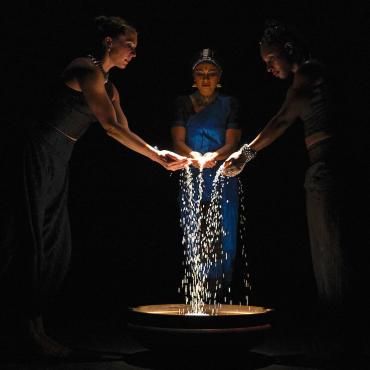
Let the Crows Come In, by Ashwini Ramaswamy (2019 Jerome Hill Artist Fellow).
